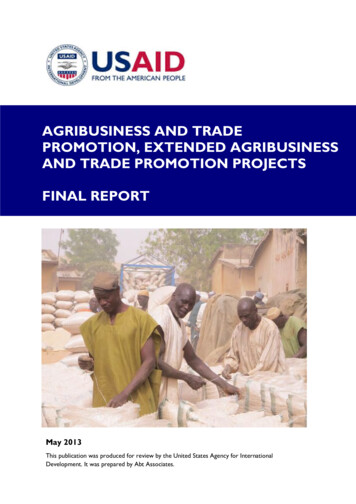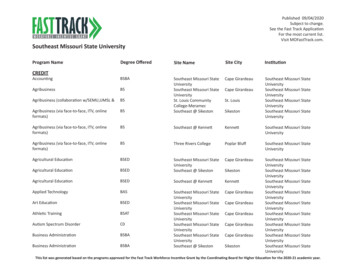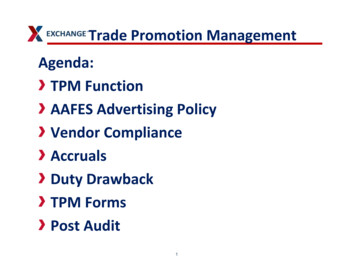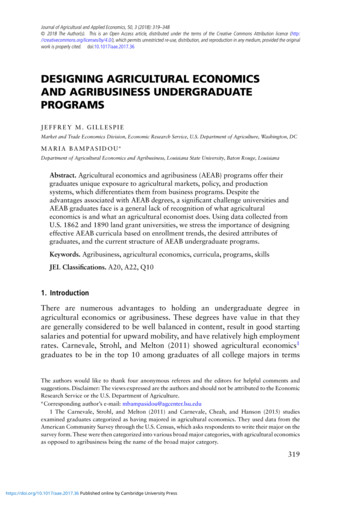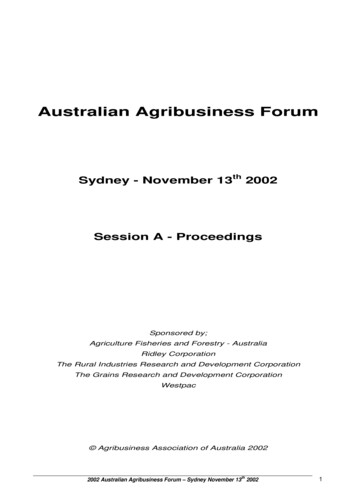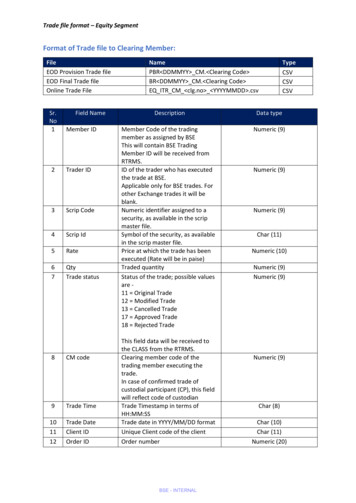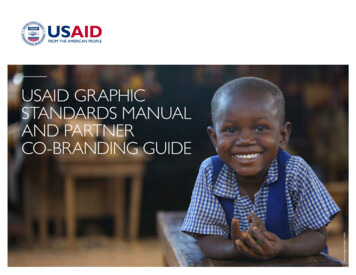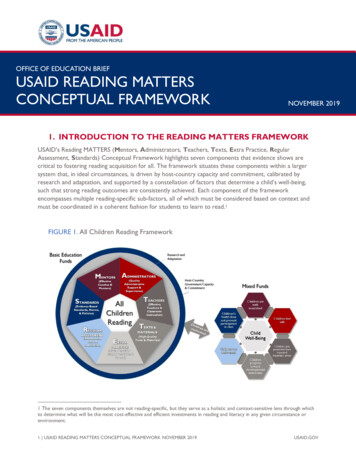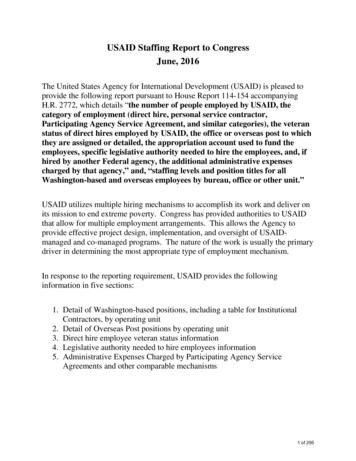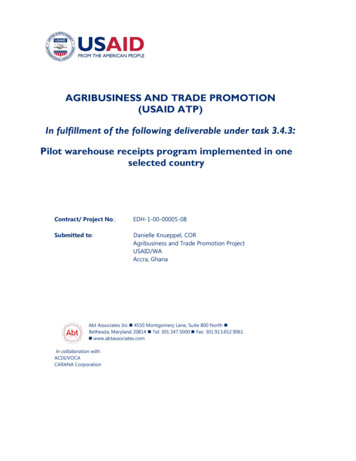
Transcription
AGRIBUSINESS AND TRADE PROMOTION(USAID ATP)In fulfillment of the following deliverable under task 3.4.3:Pilot warehouse receipts program implemented in oneselected countryContract/ Project No.:EDH-1-00-00005-08Submitted to:Danielle Knueppel, CORAgribusiness and Trade Promotion ProjectUSAID/WAAccra, GhanaAbt Associates Inc. 4550 Montgomery Lane, Suite 800 North Bethesda, Maryland 20814 Tel: 301.347.5000. Fax: 301.913.652.9061 www.abtassociates.comIn collaboration with:ACDI/VOCACARANA Corporation
ASSESSMENT OF THE GHANA PILOTWAREHOUSE RECEIPT SYSTEMAGRIBUSINESS AND TRADEPROMOTION PROJECTAugust 2011This publication was produced for review by the United States Agency for International Development. Itwas prepared by Abt Associates Inc. in association with ACDI/VOCA for the Agribusiness and TradePromotion Project.
Recommended Citation: Kula, Olaf. November 2011. “Assessment of the Ghana PilotWarehouse Receipt System.” Prepared for the Agribusiness and Trade Promotion Project byAbt Associates Inc. in association with ACDI/VOCA, Bethesda, MD,Contract/Project No.:EDH-1-00-05-00005-00-08Submitted to:Danielle KnueppelCORAgribusiness and Trade Promotion ProjectUSAID/WAAccra, GhanaAbt Associates Inc. 4550 Montgomery Avenue, Suite 800 North Bethesda, Maryland 20814 Tel: 301.347.5000. Fax: 301.913.9061 www.abtassociates.comIn collaboration with:ACDI/VOCACARANA Corporation
ASSESSMENT OF THEGHANA PILOT WAREHOUSE RECEIPTSYSTEMAGRIBUSINESS AND TRADE PROMOTION PROJECTDISCLAIMERThe author’s views expressed in this publication do not necessarily reflect the views of the United StatesAgency for International Development (USAID) or the United States Government.
CONTENTSContents . iiiAcronyms . vAcknowledgments . viiExecutive Summary. ix1.BackGround. 11.1 Warehouse Receipts: A Definition. 11.2 History of Warehouse Receipt Initiatives in Ghana . 21.2.1 Warehousing Initiatives. 21.2.2 Warehouse Receipt Initiatives . 31.3 The GGC Warehouse Receipts System Pilot . 52.Progress to Date . 72.1 Incorporation . 72.2 Constitution of a Board of Directors . 72.3 Establishment of a Regulatory Framework for Warehousesand Stored Commodities . 72.4 Assessment of Existing Warehouse Capacity . 82.5 Membership and Affiliation . 82.6 Building Broad-Based Stakeholder Support . 92.7 Azarkinmu: The Missing Link . 93.Challenges .114.Lessons Learned .155.The Way Forward: GGC’s Plans for AchievingOperational Self-Sufficiency .175.15.25.35.4Warehouses . 17Attracting Capital. 18Risk Management .18Time Needed to Build a Sustainable WRS .19Annex 1: GGC Warehouse Regulations .21Annex 2: GGC Strategic Plan .59iii
ACRONYMSvABCAgribusiness CenterADBAfrican Development BankADVANCEAgricultural Development and Value Chain EnhancementAfDBAfrican Development BankAGRAAlliance for a Green Revolution in AfricaATPAgribusiness and Trade PromotionCMACollateral management agencyFASCOMFarmer Services CompanyFBOFarmer-based organizationFIFinancial institutionGGCGhana Grains CouncilGHCGhanaian CedisGFDCGhana Food Distribution CompanyGFWGGrain and Feed Working GroupGSBGhana Standards BoardGVCGhana Venture CapitalGWRGrain warehouse receipt systemITInformation technologyMCAMillennium Challenge AccountMCCMillennium Challenge CorporationMDAMillennium Development AuthorityMISMarket information systemMOFAMinistry of Food and AgricultureMOTIMinistry of Trade and IndustryNAFCONational Food Buffer Stock CompanyNRINatural Resources InstituteNTHCNational Trust and Housing CorporationOICOpportunities Industrialisation CentrePIOMPhysical infrastructure, ownership, and managementURADEPUpper Regional Agricultural Development Project
USAIDUnited States Agency for International DevelopmentWFPWorld Food ProgrammeWRCTEFWarehouse Receipts and Commodities Exchange Task ForceWRSWarehouse Receipt SystemWRSJMCWarehouse Receipt System Joint Monitoring Committeevi
ACKNOWLEDGMENTSThe author wishes to thank all those who generously provided information and/or theirexperiences related to the assignment, including the staff and management of the GhanaGrains Council (GGC), nongovernmental organizations, representatives of the Ministry ofTrade and Industry and Ministry of Food and Agriculture, stakeholder associations, collateralmanagers, and staff of United States Agency for International Development (USAID)/Ghana,and USAID/West Africa.The author is grateful for the support of staff from the Agribusiness and Trade Promotion(ATP) Project, notably Ismael Ouedraogo and Bechir Rassas, who have continued to supportthe grain warehouse receipt pilot and have remained committed to learning from it despitehurdles and delays. Thanks to Sophie Walker, Jonathan Coulter, Sam Owusu, and theremaining GGC board members for informing this study.The author also wishes to express his appreciation and gratitude to Mr. Emmanuel Mante,program manager of the GGC who passed away suddenly on September 7, 2011. Mr.Mante’s vision and dedication have brought Ghana closer than even to having a viable andthriving warehouse receipt system. Mr. Mante did not get to see his vision come to fruition,but he lit the torch for others to carry.vii
EXECUTIVE SUMMARY“The major problem in establishing Warehouse Receipt systems in Africa is disabling elementsin the policy environment the most crucial [factor in overcoming this challenge is] buildingstrong stakeholder support behind the initiative.1”On February 18, 2010, the Ghana Grains Council (GGC) was incorporated as a privatecompany limited by guaranty. Once registered as a company, the GGC became a grantee ofthe USAID-funded Agribusiness and Trade Promotion (ATP) project. Subsequent to the initialgrant from ATP, the USAID-funded Agricultural Development and Value Chain Development(ADVANCE) project provided additional technical assistance and grant funding.This landmark event was the first time a private industry group had come together for thepurpose of creating an industry self-regulatory body for the operation of a national-levelwarehouse receipt system (WRS). Earlier public-private collaborations to develop awarehouse receipt system for cereals had not succeeded for a variety of reasons. Was the2010 initiative different, and if so, why?The GGC has three core objectives: creating and managing a national warehouse receiptingsystem, facilitating greater public-private dialogue in the cereals industry, and integrating theproduct of smallholder farmers into more competitive markets. It has a tiered membershipstructure open to all cereal industry participants and service providers, from farmers toindustrial buyers. Its business model is based on cost recovery through fees from services,particularly those associated with the management of the national WRS. To date, the GGChas raised almost 100,000 in paid-in capital from 17 members.How much progress has the GGC made in developing a Ghana WRS? What obstacles has itencountered? What successes has it achieved, and what have we learned that can guidesimilar initiatives in the West Africa sub-region? Has the WRS pilot been a success orsomething less? The answer, of course, depends on the criteria and metrics used to assessGGC’s progress on the WRS pilot.The GGC has been successful in creating the essential foundation for a WRS in a dynamicand complex enabling environment. Initial achievements include: Development of a regulatory framework and establishment of rules and standards forcertified warehouses, with participation from collateral management agencies (CMAs)and financial institutions Communication of warehouse standards to the Government of Ghana and developmentpartners who are funding warehouse construction to ensure that new warehousescomply with GGC standards1Coulter, Onumah.“ The role of warehouse receipt systems in enhanced commodity marketing and rural livelihoods in Africa.” Food Policy 27,319–337. 2002.ix
Twelve warehouses under construction according to GGC guidelines, ten agribusinesscenters (ABCs) with funding from the Millennium Challenge Account (MCA), and twowarehouses funded by ADVANCE to begin construction in September Authorization of drawings by GGC and a bill of quantity established for new warehouseconstruction Leadership in an inter-ministerial task force that is in place to establish a WRS and acommodity exchange law Recruitment of four financial institutions as GGC members; two non-bank financialinstitutions on the GGC board Ongoing training of warehouse operators in grades, standards, and managementrequirements for certified warehouses Completion of sensitization and public information events to inform stakeholders of theGGC and the role of a WRS in improving grain quality, smoothing prices, and facilitatingfinancing to farmers and tradersA clear and solid foundation for the development of a national WRS is in place. There issubstantial private sector interest in the WRS and, importantly, this interest has been backedwith a commitment of time and capital by interim board members to get the GGC and theWRS up and running. Multiple development partners, including the Minister of Food andAgriculture and the Minister of Trade and Industry, recognize the GGC as the leadingindustry body in the initiative to develop a national WRS. This public-private partnership todevelop a policy and regulatory environment in support of warehouse receipt systems andcommodity exchanges that assumes private sector management is without precedent inGhana. This, indeed, is an important milestone.At the time of this report, however, there were not yet any certified warehouses, warehousereceipts for currently stored cereal, or bank financing using warehouse receipts as collateral.While much has been accomplished by the GGC in the WRS pilot, and the foundation for asound and nationwide WRS is in place, the GGC and the ATP and ADVANCE projectsunderestimated some of the challenges to building a sustainable WRS in Ghana. This has ledto delays in launching a fully operational WRS.Building sustainable institutions, even with significant levels of private investment, takes time.While the GGC has a strong chance of achieving operational self-sufficiency in the next fourto five years, it will not reach that point without donor or public sector commitment to itssustainability.x
1. BACKGROUND1.1WAREHOUSE RECEIPTS: A DEFINITIONWarehouse receipts (WR) are documents issued by warehouse operators as evidence thatspecified commodities of stated quantity and quality have been deposited at particularlocations by named depositors. Producers, traders, and processors deposit commodities at acertified warehouse. The warehouse promises secure and safe storage, and issues a receiptto the depositor, certifying that it is in possession of a specified quantity of a particularcommodity that meets specified standards. The depositor can then use that receipt as apledge to secure a loan from a bank or other lender. The lender places a lien on thecommodity, so that it cannot be sold without the proceeds first being used to repay theoutstanding loan. In this scenario, the lender can dispose of the pledged goods only if theborrower defaults on the loan. Otherwise, title and any changes in the value of the depositedcommodity belong to the depositor/borrower. A depositor can also transfer the receipt to abuyer, who in turn can take possession of the commodity at the warehouse. Taxes, storagefees, loan principal, and interest are deducted before delivery is made by the warehouse.The advantages to a warehouse receipting system are numerous. Producers and traders gainaccess to reliable storage. This helps lower post-harvest losses and smooths prices as farmersand traders can sell their product over time. Deposits serve as a new source of collateral, andwarehouse records allow depositors to build a transaction history. Warehouse receipts allowlenders to reduce screening, monitoring, and transaction costs, as many of these are builtinto the receipt system.Warehouse receipt systems reduce buyers’ doubts about product availability and timelydelivery. Standards allow buyers to purchase commodities without needing to sample theproducts of individual producers. All of these benefits reduce the costs and risks associatedwith transactions, and upgrade the marketing process so that increased value is generatedby the chain. Finally, with increased access to financing, smallholder farmers can invest in thenext season’s inputs and preparation without being forced to sell their commodity.Warehouse receipts work well for large-scale commodity producers and traders. They are,however, a bigger challenge for smallholder farmers producing small surpluses. Smallholderfarmers have greater difficulty participating in WRS directly because they are unable toproduce commercially viable quantities for sale or storage in warehouses. Farmers mustorganize and aggregate their produce to reach commercial quantities, or assemble theirproduct through an aggregator.1
1.21.2.1HISTORY OF WAREHOUSE RECEIPT INITIATIVES INGHANAWAREHOUSING INITIATIVESVarious storage facilities for grain can be found close to production centers. These includeseveral supported by public or donor institutions and a number of private facilities. Thosesupported receive assistance primarily from government projects, and include the large, wellequipped stores of the Ghana Food Distribution Company (GFDC) for warehousing, and theFarmer Services Company (FASCOMs) built by the Upper Regional Agricultural DevelopmentProject (URADEP) in the Upper East and Upper West regions.The warehouses of the GFDC were built by government in the 1990s and are spread widelyacross the country. With capacities of 500-1000 metric tons (MT), they were built at majormarketing and production centers and in cities for sale of the produce. Many were wellplanned stores that are equipped with cleaners and bagging machines. In order to providespace for its National Buffer Stock program, the government recently released all GFDCproperties that had not been divested to the National Food Buffer Stock Company (NAFCO).At the moment, NAFCO is estimated to have a total storage capacity of 34,000 MT inwarehouse space spread across the country.The URADEP project started in 1974 and closed in September 1984. The United Kingdom andthe Netherlands provided independent funding alongside the Government of Ghana for thisproject in the Upper East and Upper West regions. Under the farm development componentof the project, 90 farm service centers were to be established by the FASCOMS to supply theinput needs of farmers. By the close of the project in December 1984, 56 of these had beenconstructed or were in the process of completion.Other government-supported warehouses in northern Ghana include the OpportunitiesIndustrialisation Centre (OIC)/Ministry of Food and Agriculture (MOFA)/community stores.Most of these are in use, despite being in varying levels of disrepair.The multi-year assistance program (MYAP) warehouses built by TechnoServe and grain banksbuilt by ActionAid constitute the next largest group of storehouses in the northern regions.Sixty-three MYAP warehouses were built in four regions (the Brong-Ahafo, Northern, UpperEast, and Upper West regions) under a USAID project managed by TechnoServe from 2005–2009.Some 20 community-level stores were built by ActionAid for farmer-based organizations(FBOs) in communities in the Upper East, Northern, and Upper West regions. Many of thesestorage houses remain in use, although most are poorly maintained. Most are now beingrented by aggregators as temporary stores of produce en route to the bigger marketingcenters. In addition, there are a large number of private stores, particularly in market centersowned by traders. Most of these use rooms within a trader’s house or rent market stallspaces.2
1.2.2WAREHOUSE RECEIPT INITIATIVES2Several attempts at establishing a warehouse receipting system were made by variousentities since the early 1990s, an example being TechnoServe’s 1,000-ton initiatives in theAshanti and Brong-Ahafo regions. These continue in the current initiative being executed bythe GGC.Between these two initiatives, various inventory credit schemes involving collateralmanagement intermediation were undertaken, involving an individual or institution thatwanted credit for purchasing a commodity, and a financial institution. These were tripartitearrangements and involved each of the parties (the financial institution and the collateralmanagement company) having padlocks or keys, thus requiring the presence of both partiesto take commodity out of a warehouse.A short summary of the interventions is below: Early 1990s—TechnoServe implemented a community-level inventory credit schememanaged by community leaders. TechnoServe supported the system by building awarehouse for the community and providing a bank guarantee to the lending agency.The system survived immediately after TechnoServe withdrew but faltered and collapsedonce funding for TechnoServe’s moral guarantee was removed 1997—The African Development Bank (AfDB) provided finance for GFDC’s grainpurchases via an inventory credit arrangement. There was no third-party collateralmanagement involved. The Bank managed the keys to a second set of padlocks for thewarehouses and placed staff in the warehouses. This worked well because the banksknew that the Government of Ghana was the sole shareholder in GFDC, but added to thecost of monitoring the credit. 1997 onwards—Private sector companies such as Maduco Grains Company, Joseph’sForesight Ltd., and Yahweh-Shalom Ltd. purchased grain via a tripartite arrangementbetween them and the AfDB, with SGS as collateral manager. 1999–The Grain and Feed Working Group (GFWG) was formed under the auspices of theNatural Resources Institute (NRI). The aim was to get stakeholder involvement and pushfor a formal, nationally accepted warehouse receipts system in Ghana. This group metfrom 1999 to 2000, when a stakeholder workshop was held to summarize and sendfindings and recommendations to the Government of Ghana to establish the need for aWRS and the steps to ensure success. One of the recommendations was that GFDC bedivested to the private sector because its unannounced release of commodities into themarket was distorting prices and was a disincentive to those who invested incommodities. July 2009—USAID sponsored a mission to survey the possibility of restarting the WRSafresh as it seemed to have fallen into dormancy; the Warehouse Receipts SteeringCommittee was formed.23Source: Sam Owusu, CEO of Ecosafe.
March 18, 2010—The GGC was formed, with a steering committee as interim board. Oneof its mandates was to establish a certified warehouse receipts system with funding fromUSAID. GGC has gone about this in a systematic way and has worked to ensure that themajor components of a good WRS are being put in place.The critical success factors for a functioning WRS include:a) A network of well-constructed, properly located warehouse infrastructure that can becertified to receive commodities. Twelve warehouses are being constructed accordingto GGC standards—ten by the Millennium Development Authority (MiDA), and twoby the ADVANCE project.b) Legally enforceable grades for the commodities to serve as a basis and reference fortransactions between parties. GGC rules and regulations comply with Ghana StandardsBoard (GSB) standards; they are further working with the GSB and large industrialbuyers to ensure that standards are responsive to industry requirements and complywith consumer safety requirements.c) Collateral management services that ensure the participating financial institutions (FIs)that quality and quantity of stock are secure, through regular physical checks in thewarehouses. A collateral management company is being recruited to perform thistask in the GGC WRS.d) Financial institutions that trust the system and are willing to give finance/credit againstthe receipt. GGC is has drafted rules and regulations for the operation of the WRSwith the input of three financial institutions to ensure that the system addresses therisk concerns of the banking sector.e) An open and transparent market information system (MIS) to help determine when tobuy as well as when to liquidate stocks. GGC has surveyed the current MIS scene andis currently negotiating with Esoko, a private agricultural marketing and priceinformation platform, to provide timely and reliable market information to supportthe WRS.f)Insurance/bonds for warehouses and commodities against losses due to fires, floods,etc., as well as employee malfeasance. GGC is currently negotiating with insurancecompanies to develop appropriate products for the WRS.g) An arbitration system to help avoid costly and protracted legal battles in case ofdisputes. This is specified in the GGC rules and regulations framework.h) Strong private sector leadership. The GGC has a strong board of directors representingdifferent value chain stakeholders and service providers. Over the last year this boardhas demonstrated a serious commitment to building a sustainable WRS in Ghana.It is hoped that with this more structured approach and with government and stakeholdersupport, the current WRS initiative will succeed and grow to rival those in more developedeconomies.4
1.3THE GGC WAREHOUSE RECEIPTS SYSTEM PILOTThe GGC is the initiative of a diverse group of private sector actors who came togetherduring a workshop in July 2009 to assess the lessons learned from previous initiatives tocreate a national WRS, and to determine if the time was right and sufficient private sectorinterest existed to create one. This workshop followed an initial and favorable ATPassessment on the feasibility of creating a national WRS in Ghana with ATP support.3 Broadinterest in and support for the premise that Ghana was ready for a national WRS wasexpressed by industrial grain buyers for food and feed, bank and non-bank financialinstitutions, collateral management companies, grain traders, and farmer grouprepresentatives.From the participants at this workshop, a core group of three firms—Premium Foods, theSoftTribe, and Ecosafe—came together with ATP to initiate technical assistance to form theGGC. This core group, operating as the interim board, has expanded to eight members,including the Commodity Clearing House (CCH), Agrimat, and most recently the NationalTrust and Housing Corporation (NTHC), along with ACDI/VOCA as an ATP subcontractor andimplementer of the ADVANCE project.35Wanzie, Rose and Charlie Stathacos. “Maize Warehouse Receipt Pilot.” Bethesda, MD: Prepared by Abt Associates Inc. Bethesda MD. 2009.
2. PROGRESS TO DATE2.1INCORPORATIONThe GGC was established as a legal entity, registered as a “company limited by guarantee,”on February 17, 2010. The GGC was initiated by interested industry leaders with support fromUSAID (through the ADVANCE and ATP projects) to put in place and manage a nationwidegrain warehouse receipt system (GWR). The Ghana Grains Council’s mission is to contributeto the establishment and enforcement of transparent rules, regulations, and standards toensure a competitive industry while protecting the public interest.GGC’s core objectives are to: Develop advocacy capacity within the industry to pursue favorable state policies for thegrain industry Initiate and develop a WRS, within which the GGC will be responsible for certifying andenforcing agreed standards for the grains industry2.2CONSTITUTION OF A BOARD OF DIRECTORSThe GGC is currently governed by an eight-member interim board representing foodprocessing, finance, collateral management, information technology (IT) services andsecurities. The interim board members are Tom Gambrah of Premium Foods Ltd., serving asChairman; Karen Hendrickson Nwaobi of the SoftTribe, serving as Vice Chairperson; SamOwusu of EcoSafe; Alexis Aning of CCH Finance; Olaf Kula of ADVANCE; Nana Yaw Obeng ofAgrimat; and Albert Walter Nii Quarco of NTHC; the latter all serving as Members. The GGCoperates from a small office with a staff of five, located at Haatso in Accra.2.3ESTABLISHMENT OF A REGULATORY FRAMEWORK FORWAREHOUSES AND STORED COMMODITIESIn collaboration with the World Food Programme (WFP), the World Bank, the MillenniumChallenge Corporation (MCC)-MiDA, and the Alliance for a Green Revolution in Africa(AGRA), the GGC drafted a set of standards and regulations for warehouses to be certified bythe GGC. These regulations are attached in Annex 1. The GGC regulatory framework is beingintegrated into the warehouse receipt and commodity exchange law, currently being draftedby multi-stakeholder taskforces and chaired by MOFA and the Ministry of Trade and Industry(MOTI).7
2.4ASSESSMENT OF EXISTING WAREHOUSE CAPACITYThe GGC completed an assessment of existing privately owned and managed warehouses inSeptember of 2010. While there are a number of grain storage warehouses in Ghana, mostlack clear ownership and management structures or are owned by the government. Eventhough the smallholder farmers of most grain-growing areas have little access to properstorage and reliable markets, there are several produce storage depots and warehouses thatwere built by successive governments (such as the FASCOMs and several fertilizer depots inthe Upper West and Upper East regions, and the OIC/MOFA/community and InternationalFund for Agricultural Development warehouses in the northern regions), as well as by privateindividuals and non-government/religious organizations. These structures, originally built forstoring farm inputs and/or produce for FBOs, are currently either being rented byaggregators for temporary storage of their grains or left idle and falling into disrepair. Forexample, out of 47 FASCOM facilities and stores inspected in 2009 by the office of theRegional Minister of Agriculture in the Upper West region, only two are in use and the resthave either been abandoned or need extensive rehabilitation for further use. A similarexercise for the northern and Upper East region indicated the same lack of suitable facilities.This assessment also established that very few privately owned and managed warehouseswere structurally sound enough to support investments to bring them up to GGC standards.2.5MEMBERSHIP AND AFFILIATIONAs of the close of September 2011, the GGC has 17 members in good standing and paid-incapital of 174,000 GHC. Members include FBOs, traders, millers, collateral managers, inputcompanies, and financial institutions.The GGC has been represented at several donor- and government-sponsored conferences,where issues of advocacy related to warehousing, commodity exchanges, and agriculturedevelopment were discussed. The GGC is a member of the Warehouse Receipts andCommodities Exchange Task Force (WRCETF), which was established and located at MOTI.This committee is working to ensure the passage of the warehouse and commoditiesexchange laws for Ghana, with United Nations Development Program (UNDP) support.Members of the WRCETF include representatives from multiple ministries and governmentagencies, including Trade and Industry, Food and Agriculture, Justice, the National FoodCompany, the Ghana Standards Board, and the Securities and Exchange Commission.With support from the World Bank, the GGC initiated a forum that resulted in the formationof an inter-ministerial Warehouse Receipt System Joint Monitoring Committee (WRSJMC) onMarch 9, 2011. The GGC brings private sector participation to this committee, which ischarged with monitoring the progress of work towards the establishment of WRS in Ghana.The secretariat of the WRSJMC is located at MOFA and includes members from the Ministriesof Food and Agriculture, Trade and Industries, Finance and Economic Planning, and localgovernment. Other members are the Agricultural Development Bank, Ghana StandardsBoard, GGC, ACDI/VOCA and the World Bank.8
2.6BUILDING BROAD-BASED STAKEHOLDER SUPPORTThe GGC has worked hard and achieved significant results in building broad-based supportamong private, public, and development partner stakeholders. This support is key in buildinga viable, private-sector supported WRS. The trade-off in this process is that expectations forthe GGC to deliver are high, despite the fact that the next key piece to building a sustainableWRS—a viable network of
AGRIBUSINESS AND TRADE PROMOTION (USAID ATP) In fulfillment of the following deliverable under task 3.4.3: Pilot warehouse receipts program implemented in one selected country Contract/ Project No .: EDH-1-00-00005-08 Submitted to : Danielle Knueppel, COR Agribusiness and Trade Promotion Project USAID/WA Accra, Ghana
